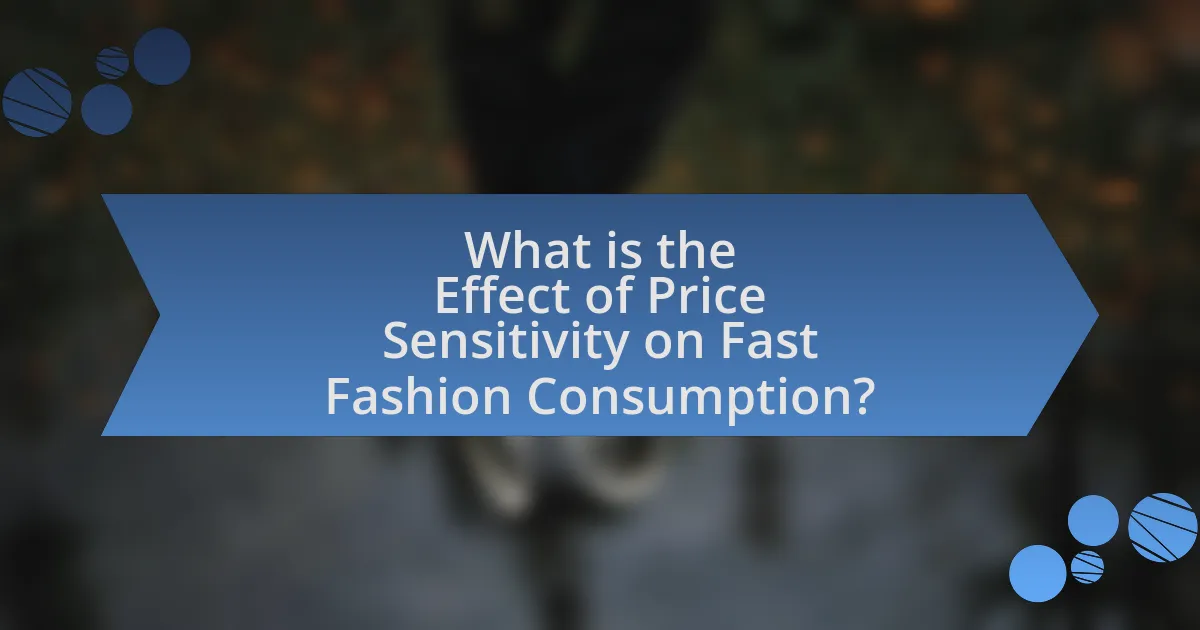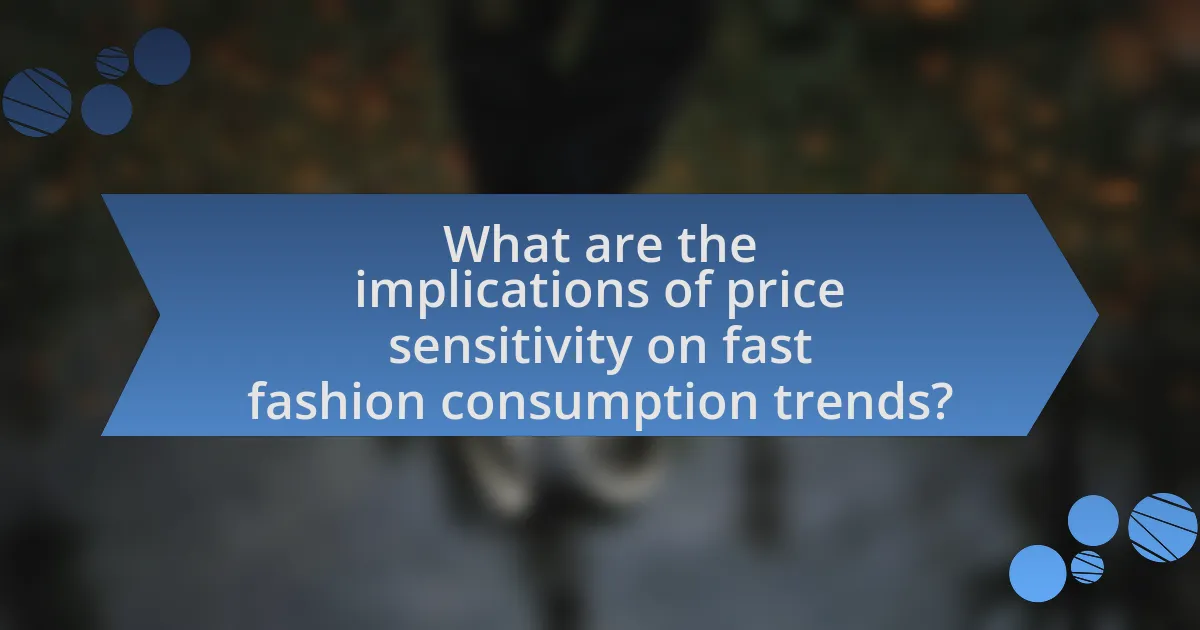The article examines the impact of price sensitivity on fast fashion consumption, highlighting how affordability drives consumer behavior in this sector. It discusses the correlation between price sensitivity and purchasing decisions, revealing that consumers prioritize low prices and discounts over brand loyalty. Factors influencing price sensitivity, such as income levels and demographic variations, are analyzed, along with the implications for fast fashion brands in terms of pricing strategies and customer engagement. Additionally, the article explores future trends, including the growing importance of sustainability and technological advancements in shaping consumer behaviors.

What is the Effect of Price Sensitivity on Fast Fashion Consumption?
Price sensitivity significantly influences fast fashion consumption by driving consumers to prioritize affordability over quality. Research indicates that consumers with high price sensitivity are more likely to purchase fast fashion items due to their low prices and frequent sales promotions. For instance, a study published in the Journal of Fashion Marketing and Management found that price-sensitive consumers are motivated by discounts and perceive fast fashion brands as offering better value for money compared to traditional retailers. This behavior leads to increased purchasing frequency and volume, as consumers feel empowered to buy more items at lower prices, ultimately shaping the fast fashion market dynamics.
How does price sensitivity influence consumer behavior in fast fashion?
Price sensitivity significantly influences consumer behavior in fast fashion by driving purchasing decisions based on affordability and perceived value. Consumers who exhibit high price sensitivity are more likely to seek out discounts, promotions, and lower-priced alternatives, leading to increased sales during sales events and clearance periods. Research indicates that approximately 70% of fast fashion consumers prioritize price over brand loyalty, demonstrating that price sensitivity directly correlates with the frequency of purchases and brand switching. This behavior is further supported by the rapid turnover of styles in fast fashion, which encourages consumers to buy more frequently at lower price points, reinforcing the cycle of consumption driven by price sensitivity.
What factors contribute to price sensitivity among fast fashion consumers?
Price sensitivity among fast fashion consumers is primarily influenced by income levels, brand loyalty, and the availability of alternatives. Consumers with lower disposable incomes tend to prioritize affordability, making them more sensitive to price changes. Additionally, fast fashion brands often rely on transient trends, leading consumers to perceive items as less valuable, which heightens their price sensitivity. Research indicates that 60% of fast fashion shoppers consider price as a critical factor in their purchasing decisions, highlighting the significant impact of economic factors on consumer behavior in this sector.
How does price sensitivity vary across different demographics in fast fashion?
Price sensitivity in fast fashion varies significantly across different demographics, influenced by factors such as age, income, and cultural background. Younger consumers, particularly Generation Z, exhibit higher price sensitivity due to limited disposable income and a strong emphasis on value for money. In contrast, older demographics, such as Millennials and Gen X, may prioritize brand loyalty and quality over price, resulting in lower price sensitivity. Additionally, income levels play a crucial role; lower-income consumers are generally more price-sensitive, while higher-income individuals may be willing to pay a premium for perceived quality or brand prestige. Research indicates that cultural factors also affect price sensitivity, with consumers in collectivist cultures often more price-sensitive due to social influences on purchasing decisions.
Why is understanding price sensitivity important for fast fashion brands?
Understanding price sensitivity is crucial for fast fashion brands because it directly influences consumer purchasing behavior and overall sales performance. Fast fashion brands operate in a highly competitive market where consumers are often price-conscious and seek value for money. Research indicates that a 1% decrease in price can lead to a 2% increase in sales volume, highlighting the significant impact of price sensitivity on revenue. By accurately gauging price sensitivity, brands can optimize pricing strategies, enhance promotional efforts, and ultimately improve customer retention and market share.
What strategies can fast fashion brands implement based on price sensitivity insights?
Fast fashion brands can implement dynamic pricing strategies based on price sensitivity insights to optimize sales and inventory turnover. By analyzing consumer behavior and demand elasticity, brands can adjust prices in real-time, offering discounts during peak shopping times or on overstock items to attract price-sensitive customers. Research indicates that 70% of consumers are influenced by price changes, highlighting the importance of strategic pricing in driving purchases. Additionally, brands can utilize tiered pricing models, where products are offered at various price points to cater to different segments of price sensitivity, thereby maximizing market reach and profitability.
How does price sensitivity affect brand loyalty in the fast fashion sector?
Price sensitivity negatively affects brand loyalty in the fast fashion sector, as consumers often prioritize low prices over brand allegiance. Research indicates that when consumers perceive prices as high, they are more likely to switch brands for better deals, leading to decreased loyalty. A study published in the Journal of Fashion Marketing and Management found that 70% of fast fashion consumers reported being influenced by price promotions, demonstrating that price sensitivity drives them to seek alternatives rather than remain loyal to a specific brand.

What are the implications of price sensitivity on fast fashion consumption trends?
Price sensitivity significantly influences fast fashion consumption trends by driving consumers to prioritize affordability over quality and sustainability. As consumers become more price-sensitive, they tend to favor brands that offer lower prices, leading to increased demand for fast fashion retailers that frequently update their collections at competitive prices. This trend is supported by data indicating that 60% of consumers consider price as the most important factor when making clothing purchases, which encourages brands to adopt aggressive pricing strategies and rapid production cycles. Consequently, the emphasis on low-cost apparel often results in a decline in the perceived value of quality and ethical production, further entrenching the fast fashion model in consumer behavior.
How do economic factors impact price sensitivity in fast fashion?
Economic factors significantly influence price sensitivity in fast fashion by affecting consumers’ disposable income and purchasing power. When economic conditions are favorable, such as during periods of economic growth, consumers tend to have higher disposable incomes, leading to decreased price sensitivity as they are more willing to spend on fashion items. Conversely, during economic downturns or recessions, consumers experience reduced disposable income, which heightens price sensitivity, prompting them to seek lower-priced alternatives or delay purchases. For instance, a study by McKinsey & Company in 2021 indicated that 60% of consumers reported being more price-conscious due to economic uncertainty, directly impacting their buying behavior in the fast fashion sector.
What role does inflation play in shaping consumer price sensitivity?
Inflation significantly increases consumer price sensitivity by eroding purchasing power and altering spending behavior. As prices rise, consumers become more aware of price changes and may prioritize essential goods over discretionary spending, leading to heightened sensitivity to price fluctuations. For instance, during periods of high inflation, such as the 1970s in the United States, consumers shifted their purchasing habits, opting for lower-cost alternatives and discount retailers. This historical context illustrates that inflation directly influences how consumers evaluate and respond to prices, making them more likely to seek value and compare options before making purchases.
How do changes in disposable income affect fast fashion consumption patterns?
Changes in disposable income significantly influence fast fashion consumption patterns, as higher disposable income typically leads to increased spending on affordable, trendy clothing. When consumers experience an increase in disposable income, they are more likely to purchase multiple items from fast fashion retailers, driven by the desire for variety and the latest trends. For instance, a study by McKinsey & Company in 2021 found that during economic upturns, fast fashion sales often rise by 10-15%, reflecting consumers’ willingness to spend more on fashion. Conversely, when disposable income decreases, consumers tend to prioritize essential purchases, leading to a decline in fast fashion consumption. This relationship highlights the sensitivity of fast fashion demand to changes in consumers’ financial situations.
What psychological factors influence price sensitivity in fast fashion consumers?
Psychological factors that influence price sensitivity in fast fashion consumers include perceived value, social comparison, and brand loyalty. Perceived value affects how consumers assess the worth of a product relative to its price; when consumers believe they are getting a good deal, they are less sensitive to price changes. Social comparison drives consumers to evaluate their purchases against peers, often leading to increased price sensitivity if they feel their choices do not align with social norms. Brand loyalty can also mitigate price sensitivity, as loyal customers may prioritize brand identity over cost, leading them to accept higher prices for favored brands. Research indicates that these psychological factors significantly shape consumer behavior in the fast fashion market, influencing purchasing decisions and overall consumption patterns.
How does perceived value affect price sensitivity in fast fashion purchases?
Perceived value significantly influences price sensitivity in fast fashion purchases, as consumers are more likely to accept higher prices when they believe the product offers greater value. Research indicates that when shoppers perceive fast fashion items as trendy, high-quality, or unique, their willingness to pay increases, reducing their sensitivity to price changes. For instance, a study published in the Journal of Fashion Marketing and Management found that perceived quality and brand reputation directly correlate with consumers’ price tolerance, suggesting that enhancing perceived value can mitigate price sensitivity.
What impact does marketing and advertising have on consumer price sensitivity?
Marketing and advertising significantly reduce consumer price sensitivity by creating perceived value and brand loyalty. When consumers are exposed to effective marketing strategies, such as emotional storytelling or influencer endorsements, they often associate higher value with the product, leading them to be less sensitive to price changes. For instance, a study published in the Journal of Marketing Research found that brands that invest in emotional advertising can increase consumer willingness to pay by up to 20%. This indicates that well-executed marketing not only enhances brand perception but also diminishes the likelihood of consumers reacting negatively to price increases, thereby influencing their purchasing behavior in the fast fashion sector.

How can fast fashion brands adapt to price sensitivity in their strategies?
Fast fashion brands can adapt to price sensitivity by implementing dynamic pricing strategies and optimizing their supply chains. Dynamic pricing allows brands to adjust prices based on demand fluctuations, enabling them to attract price-sensitive consumers while maximizing revenue. For instance, brands like Zara utilize real-time sales data to inform pricing decisions, ensuring competitiveness in the market. Additionally, optimizing supply chains reduces production costs, allowing brands to offer lower prices without sacrificing margins. According to a McKinsey report, efficient supply chain management can lead to a 20-30% reduction in costs, directly benefiting price-sensitive consumers.
What pricing strategies can be effective in addressing price sensitivity?
Effective pricing strategies to address price sensitivity include psychological pricing, discount pricing, and value-based pricing. Psychological pricing leverages consumer perceptions by setting prices slightly below a round number, making products appear more affordable; for instance, pricing an item at $19.99 instead of $20. Discount pricing attracts price-sensitive consumers through temporary price reductions, which can increase sales volume and customer acquisition. Value-based pricing focuses on setting prices based on the perceived value to the customer rather than the cost of production, allowing brands to capture higher margins while still appealing to budget-conscious shoppers. Research indicates that fast fashion brands employing these strategies can enhance customer loyalty and increase market share, as evidenced by a study published in the Journal of Fashion Marketing and Management, which found that price sensitivity significantly influences consumer purchasing decisions in the fast fashion sector.
How can dynamic pricing models be utilized in fast fashion?
Dynamic pricing models can be utilized in fast fashion by adjusting prices in real-time based on demand, inventory levels, and consumer behavior. Retailers can analyze data from sales trends and customer interactions to optimize pricing strategies, ensuring competitive pricing while maximizing profit margins. For instance, brands like Zara and H&M frequently adjust prices based on seasonal trends and stock availability, which allows them to respond quickly to market changes and consumer preferences. This approach not only enhances sales but also aligns with the fast-paced nature of the fashion industry, where trends can shift rapidly.
What role does discounting play in managing price sensitivity?
Discounting plays a crucial role in managing price sensitivity by reducing the perceived cost of products, thereby encouraging consumer purchases. When retailers implement discounts, they effectively lower the price point, making products more attractive to price-sensitive consumers who may otherwise hesitate to buy at full price. Research indicates that approximately 70% of consumers are influenced by discounts when making purchasing decisions, highlighting the effectiveness of this strategy in stimulating demand. Furthermore, discounts can create a sense of urgency and exclusivity, prompting quicker buying decisions among consumers who are sensitive to price fluctuations.
What are best practices for fast fashion brands to engage price-sensitive consumers?
Fast fashion brands can effectively engage price-sensitive consumers by implementing strategies such as offering frequent promotions, maintaining a diverse product range at various price points, and utilizing social media for targeted marketing. Frequent promotions, such as discounts and limited-time offers, create urgency and attract budget-conscious shoppers, as evidenced by a study from the Journal of Retailing which found that promotional pricing significantly increases consumer purchase intent. Additionally, a diverse product range allows consumers to find items that fit their budget, enhancing their shopping experience and increasing brand loyalty. Utilizing social media platforms for targeted marketing campaigns can also reach price-sensitive consumers directly, as 73% of millennials report being influenced by social media in their purchasing decisions, according to a survey by Sprout Social. These practices collectively enhance engagement with price-sensitive consumers in the fast fashion sector.
How can brands enhance customer experience to mitigate price sensitivity?
Brands can enhance customer experience to mitigate price sensitivity by offering personalized services and creating emotional connections with consumers. Personalization, such as tailored recommendations based on previous purchases, can increase customer satisfaction and loyalty, reducing the likelihood of price comparison. Emotional connections can be fostered through storytelling and brand values that resonate with consumers, leading to a stronger brand affinity. Research indicates that brands that engage customers emotionally can command a price premium, as seen in a study by the Harvard Business Review, which found that emotionally connected customers are 52% more valuable than those who are just satisfied.
What loyalty programs can effectively attract price-sensitive shoppers?
Loyalty programs that effectively attract price-sensitive shoppers include tiered rewards systems, cashback offers, and discounts on future purchases. Tiered rewards systems incentivize repeat purchases by providing increasing benefits based on spending levels, which appeals to shoppers looking for value. Cashback offers directly return a percentage of the purchase price, making the shopping experience more financially rewarding. Discounts on future purchases encourage immediate spending while promising savings on subsequent transactions, which is particularly attractive to price-sensitive consumers. Research indicates that 70% of consumers are more likely to engage with brands that offer personalized rewards, highlighting the effectiveness of tailored loyalty programs in attracting this demographic.
What are the future trends regarding price sensitivity in fast fashion consumption?
Future trends indicate that price sensitivity in fast fashion consumption will increase due to economic fluctuations and growing consumer awareness of sustainability. As consumers face rising living costs, they are likely to prioritize affordability, leading to a shift towards budget-friendly brands. Additionally, research shows that 66% of consumers are willing to pay more for sustainable products, suggesting that while price sensitivity is rising, there is also a segment willing to invest in ethical fashion, creating a dual trend. This evolving landscape will compel fast fashion retailers to balance competitive pricing with sustainable practices to meet diverse consumer demands.
How might technological advancements influence price sensitivity in the future?
Technological advancements are likely to decrease price sensitivity in consumers by enhancing access to information and improving shopping experiences. As technology evolves, consumers will have greater access to price comparison tools, enabling them to make informed purchasing decisions quickly. For instance, the rise of mobile apps and online platforms allows users to compare prices across multiple retailers instantly, which can lead to more competitive pricing strategies among brands. Additionally, advancements in artificial intelligence and machine learning can personalize shopping experiences, making consumers more loyal to brands that cater to their preferences, potentially reducing their sensitivity to price changes. Research indicates that personalized marketing can increase customer retention by up to 30%, demonstrating how technology can shift consumer behavior towards brand loyalty rather than price focus.
What emerging consumer behaviors should fast fashion brands monitor?
Fast fashion brands should monitor the increasing trend of sustainability-focused purchasing behaviors among consumers. Research indicates that 66% of global consumers are willing to pay more for sustainable brands, highlighting a shift towards environmentally conscious shopping habits. Additionally, the rise of second-hand shopping and rental services reflects a growing preference for circular fashion, with the resale market projected to reach $64 billion by 2024. This indicates that consumers are becoming more price-sensitive while also prioritizing ethical considerations in their purchasing decisions.















